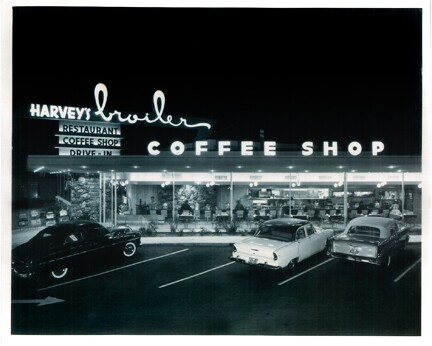Truth matters. Community matters. Your support makes both possible. LAist is one of the few places where news remains independent and free from political and corporate influence. Stand up for truth and for LAist. Make your year-end tax-deductible gift now.
With The Ban On Cruising And Lowriding Lifted, A Visit To One Of The Spots In Downey Where It All Started

Cities can no longer ban lowriders and cruising after a new California law went into effect days ago.
To Jim Louder, owner and operator of Bob's Big Boy Broiler in Downey, the end of the restrictions means just another day.
That's because his old school diner-slash-local landmark at the intersection of Firestone Boulevard and Pomering Road was historically one of L.A.'s major cruising hubs. Ban or no ban, it's not uncommon to spot one of these pieces-of-art-on-wheels in his parking lot.
"This area in the late '50s was considered sort of the heartbeat of the custom car movement," Louder said. "There was customizers and painters up and down here on Firestone Boulevard."
Louder said this was where drivers and enthusiasts came to get their cars fixed up, painted and — in today's parlance — tricked out, as part of a car customization culture including hot rods and lowriders that took off after World War II.
To meet the zeitgeist, a giant restaurant with an equally giant parking lot sprouted up in 1958. That restaurant is called Harvey's Broiler — the predecessor to Louder's Bob's Big Boy that sat at the very same spot decades ago.

Its owners Harvey and Minnie Ortner tapped local architect Paul Clayton to construct a futuristic drive-in diner — the kind where food is delivered right to your car — at a former chicken farm in the hopes of luring hungry drivers off the road. And a lure it quickly became, drawing thousands of cars, on weekend nights in the 1960s.
"It was where kids got together to find out what was going on," Louder said. "They would cruise to a certain restaurant and then, you know, the other kids would be hanging out and they would find out where's the party, where's the race, where's something going on that they wanted to go to.
"The [restaurant] had a mile long of cars in line waiting to get on the parking lot, waiting to just cruise through and then get back in line again."
Harvey's legends were such that when Tom Wolfe decided to write about America's teenage car culture, he told it through the prism of the Downey restaurant.
He wrote in the essay The Hair Boys: “They cruise around in their cars in Harvey’s huge parking lot, boys and girls, showing each other the latest in fashions, in cars, hairdos (male and female) and clothes in the Los Angeles Teenage . . . and Second-Generation Teenage . . . modes, Teenage Paris! Harvey’s Drive-in!"
In the late '60s, Harvey's changed its name to Johnie's Broiler and maintained its place in the cruising culture, but by the 1980s many cities in the state started to ban cruising and lowriding — just as the latter was becoming prominent in the cultural mainstream.
It ushered in the end of an era for the drive-in diner as well. By the early 2000s, Johnie's and its parking lot were turned into a used car dealership — only to be demolished, illegally, in 2007.
That was when Jim Louder stepped in, the Bob's Big Boy franchisee who just happened to be in Downey looking for a spot to build a new restaurant.
"I remember driving by this location and it looked like a bomb blew up there and I thought, 'Well, what could have happened here?' This is really weird to see something like this in the middle of a town like Downey," Louder said.
Louder signed a lease to put in a restaurant, one whose design honed close to the original Harvey's style and sensibility. The new owner tried to salvage as much of the former restaurant's leftover materials as possible, including old signage, according to the Press-Telegram.
"We had to accommodate the current building codes," Louder said. But, "it really looks pretty much the way it did when it opened in 1958."
Bob's Big Boy Broiler in Downey reopened in October 2009. It brought another defining element from way back when — the car shows, where vintage rides sporting all manners of customization and paint jobs take over its parking lot.
"We've had tremendous response [to our] car shows. A lot of people from different parts of the world attended," Louder said, including collectors from Japan, Germany and Australia.
The last car show at Bob's Big Boy in Downey took place about four months ago, Louder said, which may well be its swan song.
"It's too hard for us to try to run the restaurant and the car show," Louder said. "I'd rather have somebody else out there taking care of that part of it. And I'm in here taking care of the customers."
@elcheech Bobs big boy June 9, 2021 #bobsbigboydowney #cruising #lowriders #hotrods #c10 #carshow #carcruise #cruise #chevyc10 #bombs #bobsbigboy #classiccars
♬ Cinco De Mayo - War
But if he brings back the car shows, he said, it'd likely be in the summer, when the weather's good and folks are out and about.
In the meantime, there are the memories — the sometimes outrageous, always glorious memories.
"There was a lot of fun. We had crazy things. The guy brought a submarine one time, I mean, crazy cars like you couldn't believe, and these things came out of trailers and stuff, it was pretty wild," Louder said.








